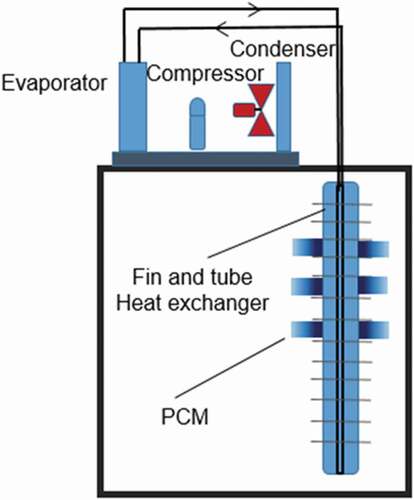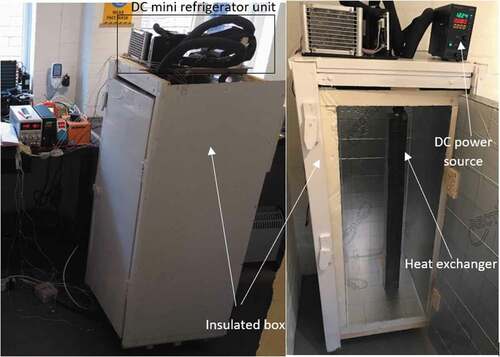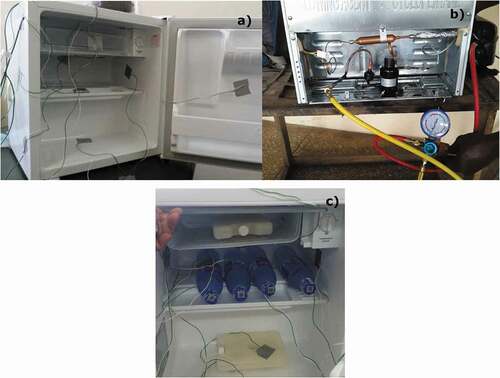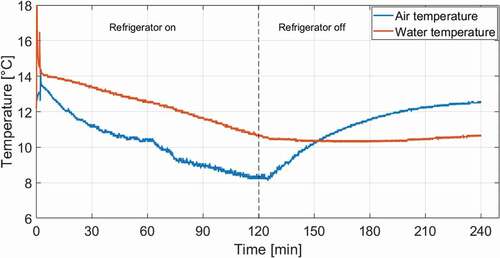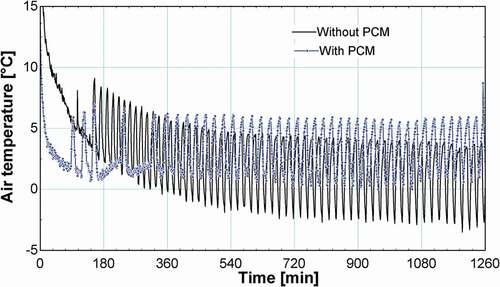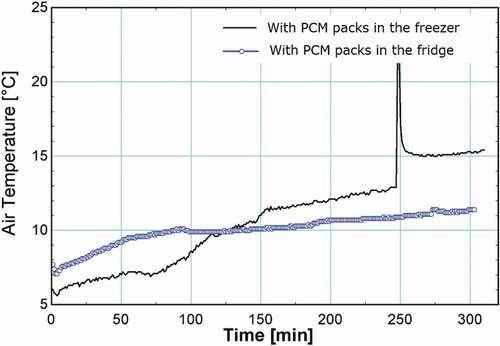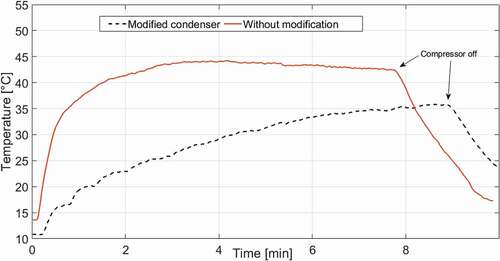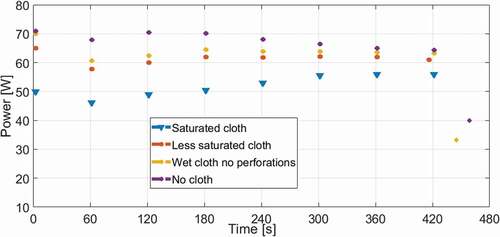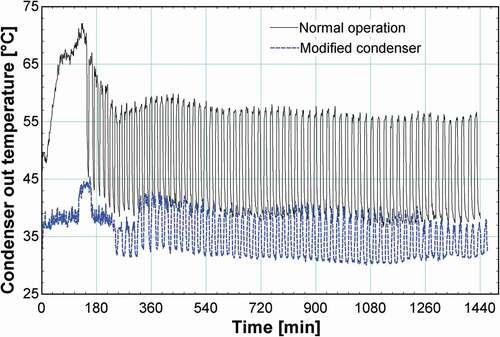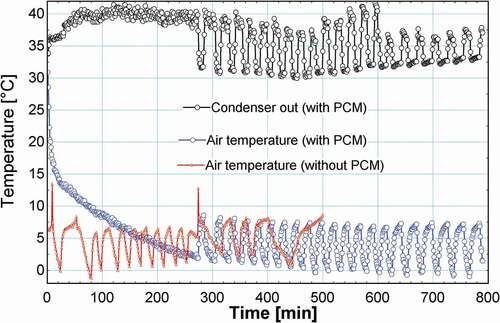 ?Mathematical formulae have been encoded as MathML and are displayed in this HTML version using MathJax in order to improve their display. Uncheck the box to turn MathJax off. This feature requires Javascript. Click on a formula to zoom.
?Mathematical formulae have been encoded as MathML and are displayed in this HTML version using MathJax in order to improve their display. Uncheck the box to turn MathJax off. This feature requires Javascript. Click on a formula to zoom.ABSTRACT
This paper presents the development of a sustainable and affordable domestic refrigerator for rural areas where grid setting is weak or non-existent. The refrigerator uses a miniature refrigeration unit based on a micro direct current (DC) compressor, which can adjust its speed according to photovoltaic output variation with solar radiation intensity, in order to maximize cooling production. The experimental investigation aims to define the cooling capacity management of the refrigerator through the use of phase change materials (PCMs). PCM packs in the fridge are charged during the period of high solar radiation and, afterward, melting of PCM releases cooling to maintain a cold temperature for extra hours when solar radiation is low or not available. The paper presents the design and construction of an experimental refrigerator with a miniature refrigeration unit of a finned tube heat exchanger for the fridge cabinet; PCM selection and, particularly, the effect of heat transfer enhancement at the condenser are discussed. Lab-scale tests were carried in the UK and field tests were carried out in Ghana in a collaboration project. In lab-scale tests, it is found that a condenser modification can decrease the transient power consumption by up to 26%. In contrast, the field-testing results show that the daily power consumption can be reduced only from 0.9 to 0.84 kWh. Additionally, field testing results show that the cabinet temperature of the PCM-enhanced refrigerator rose from 7°C to 11°C after a period of 5 hr power outage.
1. Introduction
Electricity has been recognized as one of the essential needs for modern life. It needs to be reliably available and affordable worldwide. Although the electricity generation by renewable energy sources is reaching a considerably advanced level as renewable energy plants are able to supply fully dispatchable, continuous electricity to the grid (Boretti Citation2021) by integration of artificial intelligence methods (Müller Citation2021), the electricity is still not accessible for about 18% of the world’s population (Zubi et al. Citation2016). The absence of electricity causes problems. According to the UN Environment Programme (UN Environment Programme Citation2021), poor storage and insufficient infrastructure are the main factors to cause food wastage in Africa. It is also reported that post-harvest losses can reach 50% due to a lack of cold storage and sustainable cold chain infrastructure because the majority of farmers are living in rural areas that have little or no access to electricity to power cold chains (Kuye Citation2021). However, refrigeration systems require stable grid electricity. The grid electrification for inaccessible areas has been encouraged yet difficult to implement. To meet electrification needs, applications of off-grid solar photovoltaic (PV) systems have increased significantly due to the reduction in the cost of the technology and the impact of fossil fuels (Sider, Al-Maghalseh, and Alnather Citation2019). In order to avoid and reduce food spoilage problems in Africa and developing countries, solar-powered refrigeration systems can be a suitable solution.
Solar-powered refrigeration can be categorized as PV-driven and thermal-driven systems, such as absorption refrigeration system. PV-driven systems have advantages over thermal systems in space usage and cost effectiveness (Sajid and Bicer Citation2021). Although the thermal vapor absorption refrigeration system is also able to use any waste heat for refrigeration applications, PV-assisted refrigeration system suits better for rural areas. Ammari and Ata (Bany Ata and Ammari Citation2015) compared two refrigeration systems and concluded that both systems are cost effective, but PV-driven vapor compression system is lower in total unit cost, less bulky, easily available in the market, simpler and requires low maintenance. Increment of solar PV usage worldwide because of reduction of PV cost shows that PV-driven vapor compression system is one of the most appropriate solution for high solar radiation locations especially for small refrigeration systems used for food and medicine (Aste, Del Pero, and Leonforte Citation2017). Alrwashdeh et al. (2019) carried out an economic comparison between PV-powered vapor compression system and vapor absorption refrigeration system driven by evacuated tube solar collectors. They concluded that the PV-driven system has more benefits in terms of cost effectiveness. Other studies also indicated that PV technology requires very low maintenance and repair expenses, which make this technology operationally one of the most low-cost options (Sharma Citation2011; Kumar and Kumar Citation2016; Su et al. Citation2020). According to the literature review, solar PV-driven refrigeration system has promising advantages over thermally driven sorption refrigeration systems; thus, this study aims to develop a low-cost refrigeration unit to preserve foods and medicine in remote and rural areas where the grid is not reliable.
Regarding the PV cell materials, polycrystalline silicon-type cells were considered, which are widely used in module manufacturing and are less expensive materials in the market (Fraunhofer Citation2016). Although their electricity conversion efficiency is lower compared to monocrystalline cells, their cost effectiveness made them the most popular cells in the world market. As the proposed study aims to develop a cost-effective unit, a polycrystalline-type solar PV panel is chosen.
Several studies are found in the literature regarding PV-powered refrigeration systems. Modi et al. (Modi et al. Citation2009) experimentally investigated the performance of the PV-powered AC compressor refrigerator. They reported that coefficient of performance (COP) can be obtained as 2.102 when ambient temperature is 42°C. Gupta et al. (Gupta, Bhatnagar, and Mathur Citation2014) carried out a modeling study of a 50 liters AC refrigerator to determine optimum PV power and insulation thickness. They found that a 200 W panel capacity is required to operate the refrigerator with a wall thickness of 50 mm. Opoku et al. (Opoku et al. Citation2016) did an experiment using a DC compressor and an AC compressor as different cases in PV-driven refrigeration. They presented that the DC refrigeration system is associated with less energy consumption and better cost effectiveness compared to AC refrigeration.
Thermal energy storage systems have been used for many applications such as in power plants (Boretti Citation2021), vegetable drying processes (Pankaew et al. Citation2020) and in refrigeration systems. Applications use chilled water storage, ice generation systems and dynamic cool storage systems, which utilize phase change materials (PCMs) (Fang, Tang, and Cao Citation2016). The use of PCMs in the refrigeration system can be found in literature as PCMs have various benefits on the system performance and operation. The benefits are temperature stability, increased compressor’s off time, higher evaporation temperature, and lower condensation temperature which means a better refrigeration performance. Oro et al. (Oró et al. Citation2012) investigated the cold storage capacity of PCMs in freezer during power failure periods. They showed that temperature remains lower when PCMs are placed compared to the case without PCMs. Yilmaz et al. (Yilmaz, Mancuhan, and Yılmaz Citation2020) observed the influence of PCM locations in the cabinet and found that placement on the shelves keeps cabinet temperature more homogeneous and results in energy saving. PCMs have been put in different places in a refrigerator, for example, Azzous et al. (Azzouz, Leducq, and Gobin Citation2009) used PCM on the back side of the evaporator, and they found that the integration of PCM reduces the number of the compressor on/off cycles, increases COP of the system by 5–15% and keeps the fridge cold for extra 5–9 hr. Sonnenrein et al. (Sonnenrein et al. Citation2015) used PCMs on the condenser of a refrigerator to increase the performance of the system. They reported power consumption was reduced up to 10%. Liu et al. (Liu et al. Citation2017) used the PCMs in the fresh food and freezing chambers of the fridge and tested off-peak and normal control modes. They presented PCM usage increases energy consumption during the off-peak period when used in the freezer cabinet; however, in normal operation, PCM usage in the cabinet decreases the consumption. Recently, Karthikeyan et al. (Karthikeyan et al. Citation2020) experimentally investigated the performance of the fridge with PCM arrangement in different locations (i.e. in cabinet, freezer and condenser coil). Their main conclusion is that PCM placement reduces the temperature fluctuations in the fridge. PCM modification reduces temperature fluctuation in the cabinet by 0.4°C. shows PCM placement in the refrigerators and their positive contributions. In addition to the utilization in cabinet and condenser, Bakhshipour et al. (Bakhshipour, Valipour, and Pahamli Citation2017) located the PCM with a melting temperature of 21°C on refrigeration line between condenser and expansion valve. They reported that COP is increased by 9.58%. Possible benefits of the use of PCMs in the refrigerators can be found in a well-structured review paper written by Omara et al. (Omara and Mohammedali Citation2020).
Table 1. Application of PCM in fridges (the text is arranged in the format of PCM name – melting temperature – performance improvement)
Some studies investigated solar-powered refrigerator performance with thermal heat storages. Bahloul et al. (El-Bahloul, Ali, and Ookawara Citation2015) experimentally investigated the performance of the solar-powered refrigerator. They tested the unit for 23 days and announced that for setting temperature of 0°C, average COP value was found to be 1.22. Coca-Ortegon et al. (Coca-Ortegón et al. Citation2019) tested the performance of the PV-driven refrigerator with PCMs, which have melting temperatures of 5°C and 9°C. They installed the PCM slabs on the evaporator to increase cold storage capacity and concluded that, apart from the advantages, the use of thicker PCM slabs increases the compressor’s on time and power consumption. Khan et al. (Khan, Afroz, and Karim Citation2017) investigated the effect of PCM usage on temperature change during the door opening and power failure periods. They concluded that PCM can eliminate rapid temperature increment and maintain the temperature in a desired range for 2 hr. In the refrigeration systems, R134a and R600a are commonly used refrigerants by considering energy efficiency and low global warming potential. This presented study adopts a miniature DC compressor suitable for R134a as suggested by its manufacturer. Elarem et al. (Elarem et al. Citation2017) conducted an experimental study of an R134a-used domestic refrigerator integrated with a PCM heat exchanger in the cabinet. Their results show COP is increased by 8% when PCM is used. Geete et al. (Geete, Singh, and Somani Citation2018) carried out an experimental study using PCMs in evaporator, with COP improvement achieved up to 20%.
Literature studies show that PV-driven refrigerators and the use of PCM in the refrigeration system have promising outcomes. Thus, this study aims to present a sustainable and affordable refrigerator unit for weak/off-grid settings. This would be achieved using suitable PCM storage, affordable insulation and high-performance compressor, and condenser units. Unlike the literature studies, a miniature refrigerator and a second fluid loop were used by connecting a finned-tube heat exchanger in the fridge cabinet. Since the unit is proposed for developing countries with no access to electricity or weak-grid settings, cost comparison with commercial products in the market is carried out. Apart from the lab-scale tests, field tests were carried out in Ghana to evaluate the performance of the micro-DC compressor and the effect of condenser modification. The paper is organized as follows: experimental apparatus and procedure, design of the finned-tube heat exchanger, PCM selection, testing of an experimental apparatus in laboratory and a prototype fridge onsite under real weather conditions and results of the condenser modification.
2. Experimental apparatus
The proposed unit development is considered in three parts, namely, fridge cabinet, vapor compression unit and PCM packs. shows the importance of PCM usage in the refrigerator with power outage frequency per month and average power outage duration for various countries (World Bank Citation2019). As it is seen, in the event of an 8-hr electricity cut, a cold temperature should be provided by PCM cold storage units. We can assume that daytime electricity cuts can be supplemented by solar PV; thus, 8-hr cold storage is the target.
Figure 1. Weak-grid electricity supply conditions for some developing countries (World Bank Citation2019)
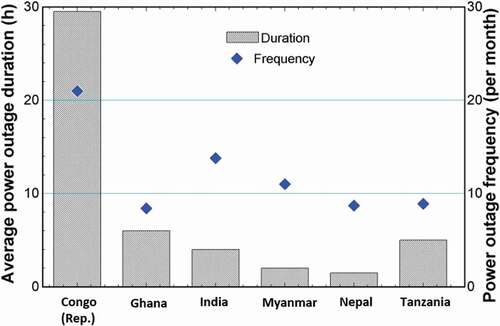
For the fridge cabinet, different sizes of refrigerators are available in the market, fridges’ inner volume varies from 100 liters to 250+ liters according to the number of people in the household. For a fridge cabinet, a 47- × 112- × 47-cm-sized box is chosen, which can be fit for many families. The chamber is well insulated to minimize heat gains from the room. For insulation, high performance PU material is used to form fridge cabinet. A wooden structure frame covered with insulation gives rigidity to the cabinet.
A vapor compression unit is adapted for refrigeration. The most common refrigeration systems have four major components: compressor, condenser, expansion device, and evaporator. The compressor increases the pressure and temperature of the working fluid. Later, heat is ejected, and the gas phase of the working fluid changes to liquid state in the condenser. After that, refrigerant pressure and temperature are reduced by an expansion device (capillary tube). Cold refrigerant absorbs heat from the refrigerated space and makes it cool, while its state is changed to gas through the evaporator. In this study, a secondary fluid loop is adopted to circulate heat transfer fluid (HTF) (glycol water) between the evaporator of the refrigeration unit and the heat exchanger in the fridge cabinet. The study aims to develop an affordable PCM-enhanced fridge by using a commercially available low-cost miniature DC-powered refrigeration unit for sub-Saharan countries. The fridge enclosure can be formed by low-cost insulation material and inexpensive efficient finned-tube heat exchanger, while a secondary fluid loop links the heat exchanger with the miniature DC refrigeration unit. The evaporator of the refrigerator is chosen to be a plate-type evaporator. A schematic view of the components of the refrigerator system is shown in .
This miniature refrigeration system adopts a micro-DC compressor and efficient heat exchangers. It can produce a cooling power of 100–400 W with a range of evaporation temperature between −18°C and 30°C. The chiller unit uses R134a as the refrigerant.
The micro-compressor has a rated voltage of 12 V DC, which makes it suitable for PV applications. Additionally, the refrigerator system has a power control unit to adjust the compressor frequency under voltage fluctuations. Voltage and current range are given as 9–16 V and 1–9 A, respectively. Displacement volume of the compressor is 1.9 cm3 with rated refrigerating capacity of 245 W and rated input power of 85 W.
The evaporator is a stainless-steel plate heat exchanger, and the condenser is a finned-tube type. The fan for the condenser also requires 12 V electricity supply. Summary of the product specifications are given in .
Table 2. Datasheet of the chiller and properties of the refrigerant and the secondary fluid
The vapor compression refrigeration system is placed on the top of the compartment; a finned tube heat exchanger enhanced with PCM improves the cooling inside the chamber. HTF is circulated between the finned tube heat exchanger and refrigerator’s evaporator. Proposed system schematic is given in .
3. Design of the finned tube heat exchanger for the fridge cabinet
The fridge cabinet is chosen as a 47- × 112- × 47-cm-sized box with a thickness of 5 cm. Inside the box, the finned tube heat exchanger is placed. Fin sizes of 7.5 × 7.5 cm with a thickness of 0.4 mm were chosen for the heat exchanger with a spacing of 4.5 mm. The total length of the heat exchanger can be determined according to the calculated sufficient heat transfer rate.
In order to calculate the heat transfer rate, fin efficiency should be determined. Unal et al. (Unal, Erdinc, and Kutlu Citation2017) used fin efficiency as 0.73 in their study for air cooling system. However, the efficiency depends on the dimensions and configuration of the heat exchanger; thus, it needs to be recalculated for each geometry of fin. To determine fin efficiency, computational fluid dynamics (CFD) study has been carried out. For aluminum fins, air-side temperature and heat transfer coefficient are assumed as 8°C and 5 W/m2K, respectively. The fluid inside the tube has a temperature of −2°C and heat transfer coefficient of 380 W/m2K. shows temperature contour on the fin. Based on the results, fin efficiency is found 0.93.
Ethylene glycol water mixture was used as HTF, and preliminary analysis shows that flow is laminar for the given conditions. Nusselt number for laminar flow is given for developing flow conditions as (Cengel Citation2003):
where and
are inner diameter and length of the copper pipe, respectively.
indicates Reynolds number and
is Prandtl number. Heat transfer coefficient can be found from Nusselt number by Eq. (2):
where is the heat transfer coefficient in the tube and
is the thermal conductivity of the HTF. Transferred heat is calculated by total thermal resistance, which consists of the inside of pipe, wall, and air-side resistances. Air-side heat transfer
is assumed to be 5 W/m2K and effective heat transfer area is calculated by Eq. (3):
is pipe surface area without fins,
is fin efficiency and
is area of the fin surface. The areas are calculated by EquationEquation (4)
(4)
(4) and Equation (5):
where is the outer diameter of the pipe,
is the number of fins,
is fin thickness.
and
are the length and width of the fin, respectively. Total thermal resistance is calculated by Eq. (6):
where and
are pipe thermal conductivity and pipe thickness, respectively.
is logarithmic mean area and calculated by Eq. (7):
Applying given equations, the heat transfer rate can be found according to temperature difference. The length of the pipe depends on the number of fins; thus, fin number can be calculated according to the required heat transfer rate.
By using predetermined fin efficiency, ) shows the effect of the number of fins on heat transfer rate; the figure also shows various temperature differences of the air and HTF, which are indicated as ΔT. As the air temperature in the fridge varies with time, cooling load also changes. However, HTF flow rate also has an influence on heat transfer. ) shows heat transfer change with the flow rate of the HTF.
Heat transfer rate from the room to the cabinet is calculated by EquationEquation (8)(8)
(8) .
comprises outside wall and inside wall heat transfer coefficients and wall conduction coefficients, which includes insulations.
Based on heat gain calculation, the maximum expected heat gain is found around 20 W. Thus, the minimum required heat transfer should be 20 W in order to maintain the cold temperature inside the cabinet. Therefore, 180 fins are chosen for the heat exchanger.
4. PCM selection
This section includes results of the work carried out to define the PCM that will be integrated into the unit to extend the time that the enclosure remains at the optimum temperature for applications. Used PCMs in the refrigeration applications can be categorized as organic, inorganic and eutectic PCMs. Organic PCMs have carbon-based composition; inorganic PCMs can be classified as salt-hydrate and metallic PCMs (Bista et al. Citation2018). Eutectic PCMs are two or more organic or inorganic components combined into one substance (Omara and Mohammedali Citation2020). Each PCM type has advantages and disadvantages; thus, PCM selection was conducted. By considering the application in this study, PCM slabs will be placed on the shelves in the fridge. As there are no contact between PCMs and the evaporator wall, PCM melting temperature needs to be selected considering the minimum and maximum air temperatures in the fridge during the operation. This consideration is required for recharging the PCMs when the refrigeration unit is on. As the proposed unit has no freezer section, sub-zero PCMs are eliminated, and targeted PCM melting temperature range is maintained as between 2°C and 5°C. Literature studies also used similar temperature ranges in fresh food cabinet application. According to the main PCM provider in the UK, PCM Products Ltd, salt-hydrate and paraffin-type PCM were offered, which are ready to commercialize and relatively cheaper, safer, etc. For more information about the PCMs for different applications or PCMs on developing stage, useful articles are suggested to the readers (Mastani Joybari et al. Citation2015; Selvnes et al. Citation2020; Du et al. Citation2017).
The PCM was selected from various products of salt hydrates and paraffins, which were produced, tested and evaluated. The PCMs need to be selected by taking into consideration factors such as technical performance, economic feasibility and safety. The selected PCM has an influence on the overall week/off-grid effectiveness of the unit. Some criterion was considered for PCM selection: small phase transition temperature range, high volumetric heat capacity, uniform freezing and melting with minimal subcooling during discharge, non-toxic, non-flammable, non-hazardous, non-corrosive, low cost and readily available. A suitable PCM candidate would meet as many criteria as possible.
In order to determine which of the PCMs available are most suitable, salt-hydrate and paraffin PCMs were tested with differential scanning calorimeter (DSC) analysis and water bath to determine the thermal energy storage potential of each candidate material in the laboratory in PCM Products Ltd (https://www.pcmproducts.net). The DSC analysis showed that salt-hydrate PCMs are not suitable for this application as results had a broad peak and a significant low-temperature shoulder, indicative of a PCM with a large difference between freezing and melting points. The water bath test also shows supercooling and a very wide phase transition region in ). These confirm that these PCMs are not suitable for the system. Therefore, organic PCMs were tested. ) shows the thermal performance of the selected PCM PlusICE A4. It has a narrow phase transition zone but does suffer a small amount of supercooling. This supercooling is negligible and should not have any major impact on the candidate PCM.
Figure 6. Thermal performance test results of the PCM with water bath, which was taken in PCM Products Ltd
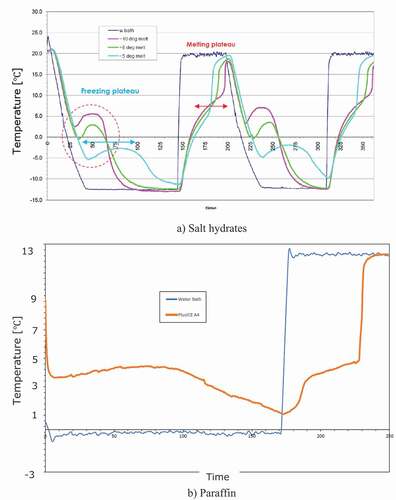
Therefore, Organic PCM PlusICE A4 is selected and used in the tests, which has a melting temperature of 4°C. PCM properties are summarized in .
Table 3. Thermophysical properties of water, plusICE hydrated salt S5, and plusICE organic A4 (Phase change material products Citation2020)
5. Construction of the system
According to the given information and design considerations, the unit has been set up at University of Nottingham’s labs. Vapor compression system was purchased from commercial sources. Heat exchanger is constructed and installed to the cabinet. Heat exchanger pipes are connected to a circulation pump and also HTF goes through the evaporator of the vapor compression unit. The refrigeration unit is placed on the top of the cabinet. Photos of the experimental set up are given in . A DC power source is connected to the control panel to represent a solar collector power input.
In order to test the performance of the micro-compressor, the modified condenser and PCM storage potential under real conditions, a test rig was set up in the Council for Scientific and Industrial Research-Institute of Industrial Research (CSIR-IIR) test room in Ghana. The components to be integrated into the fridge (PCM packs and micro-compressor) were shipped from the UK to Ghana to be assembled. The IIR, in Ghana, subsequently purchased a 45-liter refrigerator to conduct the prescribed tests. ) shows the temperature-measuring locations of the fridge. ) shows the compressor replacement with micro-compressor and ) shows one of the testing installment of water bottles and PCM packs. Measured temperatures of the normal fridge and the micro-compressor-installed fridge are compared in the following section.
6. Results and discussions
6.1. Lab-scale testing of the prototype experimental fridge
Testing of the system aims to observe temperature variation in the prototype and specified components. K-type thermocouples were placed inside the cabinet on various places. A 16-channel data logger was used to record the temperature readings using sevenK-type thermocouples. It has an accuracy of 0.05% according to the manufacturer. Power consumption was measured by plug-in energy meter with a measurement accuracy of ±2%. While conducting the experiments, different cases were considered. Test data for each case are given separately, then comparisons are conducted.
The first test was conducted to observe temperature variation by time in the prototype and the heat exchanger surface. Since CFD analysis showed that temperature on the fin surface can be 3–4°C higher than the HTF temperature, the test would give information about the evaporation temperature of the cooling unit. In the test, the prototype was empty to eliminate sensible and latent heat capacities of the containers. shows temperature variation by time. When the room temperature is around 20°C, air temperature in the box remains at 8°C and heat exchanger surface temperature was varied around 3°C.
Figure 9. Temperature variation of empty cabinet (no PCM containers, no water bottles, compressor: on)
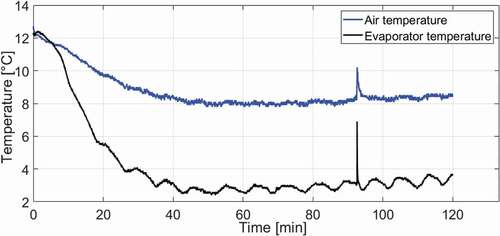
PCMs were filled in plastic containers; the mass of each container was 0.3 kg. In the second experiment, the performance of the charged PCMs was tested. When the refrigerator was off, temperatures were measured; the variation by time is given in .
Figure 10. Temperature variation of water and PCM surface (six PCM containers, one water bottle, compressor: off)
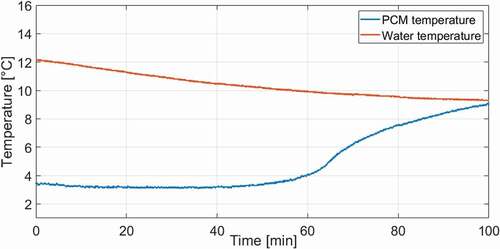
The figure shows that PCM container temperature remains the same for 1 hr. Water temperature reduces during the testing period from 12°C to 9°C because of cold storage, but air temperature increases slightly after 1 hr because PCM absorbs the maximum latent heat, and its temperature also increases. Although PCM temperature is lower than the air, temperature rise in the PCM decreases heat transfer rate from air to PCM.
In the next experiment, only water bottles (1.5 liters in total) were placed in the box; the measured temperatures are given in . The temperatures were recorded for 4 hr. Refrigerator compressor was operated during the first 2 hr, and then the compressor was turned off. It is seen from the figure that air temperature decreases from 13°C to 8°C and bottle temperature reduces from 14°C to 11°C. After the compressor is turned off, air temperature increases to 13°C, but the water temperature in the bottle increases only 1°C at the end of 2 hr.
6.2. Field tests on the effect of using PCM packs in a common 45-liter fridge in Ghana
For real condition testing to evaluate the effect of the PCM on air temperature, a 45-liter refrigerator was installed with 16 K-Type thermocouples in various location inside the refrigerator to determine the spatial temperature distribution within the interior of the fridge. During the tests, fridge door openings were included to simulate real conditions. The thermocouples were attached with tape on the walls, hanging in the air, on the tray, and on the evaporator inlet pipe inside the fridge. At the exterior of the fridge, thermocouples were attached to the compressor inlet and outlet pipes, condenser outlet pipe, and to ambient temperature. The data logger was configured to record temperature readings at 1-min intervals. Thermocouples were connected to the data logger and then to various regions within the interior and exterior of the system. In each test, 4 liters of water were placed in the cabinet to represent thermal mass. Two packs of PCMs were also placed for some experiments. shows the cold air temperatures of cases with and without PCM in the cabinet. The main difference is maximum and minimum temperatures. Since PCM has a melting temperature of 4°C, continuous heat transfer from air to PCM and from PCM to air happens during the test. When the temperature of the air is lower than 4°C, PCM absorbs heat from the air, which does not allow the air temperature to reduce fast. The temperature difference between the minimum and maximum points are also slightly lower in the PCM case. It can be concluded that PCM placement in the cabinet results in slightly higher air temperature in the PCM charging period.
shows the temperature of the fresh food cabinet for different PCM locations during the compressor-off period. As mentioned before, two PCM packs were used for testing and, in the first test, both packs were placed in the freezer side. In the second test, one of the PCM pack was placed in the fresh food cabinet. The experiment was conducted for 5 hr, and cold air temperatures were measured. The figure shows that air temperature in the first test increases more compared to the second test. This effect was from one pack of PCM placed in the food container. The air temperature reaches 15°C at the end of the test. This temperature is higher than the normal operating temperature, but this temperature is the air temperature, and food temperatures are lower than the air. Moreover, the temperature in the second case was measured as 12.5°C. Therefore, the results show that PCM location has an influence on the required time for food spoilage in power-off periods.
6.3. Lab-scale testing of the prototype experimental fridge with condenser modification
One of the targets of this paper is to improve the performance of the refrigeration system. To address this, power consumption needs to be reduced. One of the main issues of the conventional refrigeration condensers is their slow process of cooling due to the small air velocity at the condenser surface and its relatively high (room) temperature. This leads to poor heat transfer; as a result, condenser temperature increases and compressor electricity consumption increases with a low coefficient of performance of the refrigerator. To address this key issue, a design approach is proposed, which would increase the heat transfer surface of the condenser unit.
A similar idea of the heat pipe can be applied to modify the condenser. Wet clothes are covered by aluminum foil and edges are sealed to be a strip. Long aluminum bags, including wick and water, enhances the heat transfer. These aluminum strips can be attached on condenser fins or condenser tubes. Therefore, additional heat transfer area can be obtained. As the prototype fridge condenser has a fan coil heat exchanger, small wet cloth strips were attached to tubes in order to benefit from evaporative cooling. Four sets of data are given in the lab-scale testing section. Air temperature in the fridge, condenser outlet temperature and power consumption were measured and given in the figures.
The first test was conducted when the condenser was not modified in order to show conventional refrigerator performance. shows the measured temperatures from the normal unit and modified unit. As the fridge has a thermostat, the compressor stops when the air temperature drops to setting temperature. During the test, condenser outlet temperature reaches 45°C and electricity consumption starts at 70 W and decreases to 64 W. Regarding modified condenser results, the condenser outlet temperature reaches a maximum of 36°C and the power consumption starts with 50 W and ends by 58 W. Compressor-off time is different in the cases because the initial cabinet temperature of the modified condenser test was slightly higher as tests were conducted at different times.
In order to make a good comparison of the power consumptions, is given for different saturation levels of the cloths. In the figure, four sets of data are compared, which are from without modification case to saturated cloth case. For each case, the amount of water content is increased, and power consumption is reduced. It is clearly shown that this condenser modification reduces power consumption considerably according to saturation level. The figure shows that power consumption can be decreased by 26% by modifying the condenser.
6.4. Field tests of a 45-liter fridge with a modified condenser in Ghana
The condenser of the 45-liter fridge in Ghana was modified as described in section 6.3 and tested. gives measured temperatures of normal and modified condenser outlet. For the unmodified condenser, its outlet temperature varies between 55°C and 58°C when the average room temperature is 30°C. The measured outlet temperature from the modified condenser is around 40°C, which indicates a lower condensation temperature and hence results in a reduction in electrical consumption. The daily power consumption was obtained as 0.9 kWh for normal operation of the fridge and 0.84 kWh for modified condenser in operation.
6.5. Field test of a 45-liter modified fridge with a micro-DC compressor in Ghana
The micro-compressor was installed in the 45-liter fridge and a power source was connected to run the compressor for testing. shows condenser outlet temperature and cold air temperatures for the cases without PCM and with PCM. Since the condenser was modified, its outlet temperature changes between 40°C and 37°C. In the case with no PCM, the cabinet temperature reduces faster than in the case with PCM. However, the first cooling period of the PCM-used experiment takes a long time, around 4 hr, to reach the set temperature. Liquid PCM packs cause this long compressor running period; because PCMs are also cooled, their high latent heat capacity result in longer time of cooling. Temperature variations show that an installed micro-compressor can successfully provide cooling of the system in desired temperature ranges.
7. Cost-effectiveness analysis of the proposed PCM-enhanced domestic refrigerator
The cost breakdown of the system components is shown in . The figures are based on the results of market analysis. To make a good comparison for the proposed unit, a commercial PV-driven fridge in Ghana has been used. The product is $724, including a 250 W PV collector, 20 A controller and battery (PV-fridge Citation2021). The proposed system has no battery as the use of PCMs can store cold for the night periods. shows the cost breakdown of the system. The total cost is found to be $451 when all items are bought at market price. The costing shows that the proposed unit is 37% cheaper than the equivalent product.
Table 4. Summary of cost breakdown of the system
8. Conclusions
The development stages of a sustainable and affordable refrigerator unit for rural areas have been given in the paper. In order to fulfil the aims of the paper, PCM storage, efficient condenser modification and use of efficient micro-compressor objectives were carried out. Lab-scale tests and field tests were conducted at the laboratory of the University of Nottingham and the test room of CSIR-IIR in Ghana, respectively. A miniature DC compressor refrigeration unit was connected to a finned tube heat exchanger in the fridge cabinet via a secondary fluid loop. Since this PCM-enhanced fridge unit is proposed for developing countries with no access to electricity or weak-grid settings, cost comparison with commercial products in the market was carried out, and it was found that the system can be constructed 37% cheaper than a commercial product.
The miniature refrigerator uses a DC variable-speed compressor, which was adapted to operate by PV collectors. A finned tube heat exchanger was dimensioned to maintain cabinet temperature in the desired temperature range. PCM slabs were placed inside the cabinet to keep the cold temperature during the refrigerator off time. The findings from the tests can be summarized as follows:
Parallel to literature studies, PCM usage on the shelves reduces the temperature fluctuation inside the fresh food cabinet.
The lab-scale experiment results show that adding PCM packs to the fridge can maintain the desired temperature in the fridge for a longer time to cover average electricity cut period.
Condenser modification tests were carried out and, in order to reduce condenser temperature, aluminum foils with wetted wick were used on the system condenser. In this way, heat transfer was enhanced, and the power consumption of the fridge was reduced by 26%.
Field testing results showed that the cabinet temperature of the refrigerator attained a temperature of 11°C during power outage simulation of 5 hr at an average ambient temperature of 33.8°C.
Nomenclature
Table
Acknowledgments
The authors would like to thank Efficiency for Access for funding the project (RD2009) and also thank our project partners, PCM Products Ltd and Institute of Industrial Research, for supporting this project.
Disclosure statement
No potential conflict of interest was reported by the authors.
References
- Alrwashdeh, S. S., and H. Ammari. 2019. Life cycle cost analysis of two different refrigeration systems powered by solar energy. Case Studies in Thermal Engineering 16 (August):100559. doi:https://doi.org/10.1016/j.csite.2019.100559.
- Aste, N., C. Del Pero, and F. Leonforte. 2017. Active refrigeration technologies for food preservation in humanitarian context – A review. Sustainable Energy Technologies and Assessments 22:150–60. doi:https://doi.org/10.1016/j.seta.2017.02.014.
- Azzouz, K., D. Leducq, and D. Gobin. 2009. Enhancing the performance of household refrigerators with latent heat storage: An experimental investigation. International Journal of Refrigeration 32 (7):1634–44. doi:https://doi.org/10.1016/j.ijrefrig.2009.03.012.
- Bakhshipour, S., M. S. Valipour, and Y. Pahamli. 2017. Parametric analysis of domestic refrigerators using PCM heat exchanger. International Journal of Refrigeration 83:1–13. doi:https://doi.org/10.1016/j.ijrefrig.2017.07.014.
- Bany Ata, A., and H. Ammari, “Economic comparison between PV powered vapor compression refrigeration system and solar thermal powered absorption refrigeration system,” 5th Jordanian IIR Int. Conf. Refrig. Air Cond. Proc. Aqaba, Jordan, March 8- 10, 2015., no. March, p. 9, 2015, doi: https://doi.org/10.13140/RG.2.1.2547.8001.
- Bista, S., S. E. Hosseini, E. Owens, and G. Phillips. 2018. Performance improvement and energy consumption reduction in refrigeration systems using phase change material (PCM). Applied Thermal Engineering 142 (June):723–35. doi:https://doi.org/10.1016/j.applthermaleng.2018.07.068.
- Boretti, A. 2021. Integration of solar thermal and photovoltaic, wind, and battery energy storage through AI in NEOM city. Energy and AI 3:100038. doi:https://doi.org/10.1016/j.egyai.2020.100038.
- Cengel, Y. 2003. Heat transfer: A practical approach. McGraw-Hill Education-Europe.
- Coca-Ortegón, A., V. Torres, J. Müller, and A. Coronas. 2019. Modelling and simulation of a PV driven refrigerator with Phase-Change materials in the internal walls, Proceedings of EuroSun 2018, 1–12. doi:https://doi.org/10.18086/eurosun2018.04.23.
- Du, K., J. Calautit, Z. Wang, Y. Wu, and H. Liu. 2017. A review of the applications of phase change materials in cooling, heating and power generation in different temperature ranges. Applied Energy 220 (October):242–73. 2018. doi:https://doi.org/10.1016/j.apenergy.2018.03.005.
- Elarem, R., S. Mellouli, E. Abhilash, and A. Jemni. 2017. Performance analysis of a household refrigerator integrating a PCM heat exchanger. Applied Thermal Engineering 125:1320–33. doi:https://doi.org/10.1016/j.applthermaleng.2017.07.113.
- El-Bahloul, A. A. M., A. H. H. Ali, and S. Ookawara. 2015. Performance and sizing of solar driven dc motor vapor compression refrigerator with thermal storage in hot arid remote areas. Energy Procedia 70:634–43. doi:https://doi.org/10.1016/j.egypro.2015.02.171.
- Fang, G., F. Tang, and L. Cao. 2016. Dynamic characteristics of cool thermal energy storage systems - A review. International Journal of Green Energy 13 (1):1–13. doi:https://doi.org/10.1080/15435075.2014.895739.
- Fraunhofer, “Photovoltaics report,” 2016. https://www.ise.fraunhofer.de/content/dam/ise/de/documents/publications/studies/Photovoltaics-Report.pdf.
- Geete, P., H. P. Singh, and S. K. Somani. 2018. Performance analysis by implementation of microencapsulated PCM in domestic refrigerator: A novel approach. Int. J. Appl. Eng. Res 13 (19):14365–71.
- Gupta, B. L., M. Bhatnagar, and J. Mathur. 2014. Optimum sizing of PV panel, battery capacity and insulation thickness for a photovoltaic operated domestic refrigerator. Sustainable Energy Technologies and Assessments 7:55–67. doi:https://doi.org/10.1016/j.seta.2014.03.005.
- Karthikeyan, A., V. Aakhash Sivan, A. Maher khaliq, and A. Anderson. 2020. Performance improvement of vapour compression refrigeration system using different phase changing materials. Mater. Today Proc (44):3540–3543. doi:https://doi.org/10.1016/j.matpr.2020.09.296.
- Khan, I. H., H. M. M. Afroz, and M. A. Karim. 2017. Effect of PCM on temperature fluctuation during the door opening of a household refrigerator. International Journal of Green Energy 14 (4):379–84. doi:https://doi.org/10.1080/15435075.2016.1261705.
- Kingspan insulation. accessed February 20, 2021 https://www.cutpriceinsulation.co.uk/collections/kingspan/products/kingspan-tp10-pir-insulation-1200-x-2400-x-50mm
- Kumar, M., and A. Kumar. 2016. Performance assessment and degradation analysis of solar photovoltaic technologies: A review. Renewable and Sustainable Energy Reviews 78 (November):554–87. 2017. doi:https://doi.org/10.1016/j.rser.2017.04.083.
- Kuye, A., 2021. The cool solutions to Africa’s burning problems. UN Department of Economic and Social Affairs-SDG blog, accessed August 3, 2021 https://www.un.org/development/desa/un-desa-voice/sdg-blog/2021/04/980.html.
- Liu, Z., D. Zhao, Q. Wang, Y. Chi, and L. Zhang. 2017. Performance study on air-cooled household refrigerator with cold storage phase change materials. International Journal of Refrigeration 79:130–42. doi:https://doi.org/10.1016/j.ijrefrig.2017.04.009.
- Mastani Joybari, M., F. Haghighat, J. Moffat, and P. Sra. 2015. Heat and cold storage using phase change materials in domestic refrigeration systems: The state-of-the-art review. Energy and Buildings 106:111–24. doi:https://doi.org/10.1016/j.enbuild.2015.06.016.
- Mini VCC unit. https://fourseasonthermo.en.alibaba.com (accessed February 20, 2021).
- Modi, A., A. Chaudhuri, B. Vijay, and J. Mathur. 2009. Performance analysis of a solar photovoltaic operated domestic refrigerator. Applied Energy 86 (12):2583–91. doi:https://doi.org/10.1016/j.apenergy.2009.04.037.
- Müller, I. M. 2021. Feature selection for energy system modeling: Identification of relevant time series information. Energy and AI 4:100057. doi:https://doi.org/10.1016/j.egyai.2021.100057.
- Omara, A. A. M., and A. A. M. Mohammedali. 2020. Thermal management and performance enhancement of domestic refrigerators and freezers via phase change materials: A review. Innovative Food Science & Emerging Technologies 66 (September):102522. doi:https://doi.org/10.1016/j.ifset.2020.102522.
- Opoku, R., S. Anane, I. A. Edwin, M. S. Adaramola, and R. Seidu. 2016. Évaluation comparative technico-économique d’un réfrigérateur converti à courant continu (DC) et d’un réfrigérateur conventionnel à courant alternatif (AC) tous alimentés par du solaire photovoltaïque (PV). International Journal of Refrigeration 72:1–11. doi:https://doi.org/10.1016/j.ijrefrig.2016.08.014.
- Oró, E., L. Miró, M. M. Farid, and L. F. Cabeza. 2012. Thermal analysis of a low temperature storage unit using phase change materials without refrigeration system. International Journal of Refrigeration 35 (6):1709–14. doi:https://doi.org/10.1016/j.ijrefrig.2012.05.004.
- Pankaew, P., O. Aumporn, S. Janjai, S. Pattarapanitchai, M. Sangsan, and B. K. Bala. 2020. Performance of a large-scale greenhouse solar dryer integrated with phase change material thermal storage system for drying of chili. International Journal of Green Energy 17 (11):632–43. doi:https://doi.org/10.1080/15435075.2020.1779074.
- Phase Change Material Products. Subzero PCMs List. accessed December 7, 2020 https://www.pcmproducts.net/files/PCMRange2020Rev-Bpdf
- PV-fridge. accessed March 1, 2021 https://www.jumia.com.gh/hig-solar-fridge-250w-greywhite-14006478.html.
- Sajid, M. U., and Y. Bicer. 2021. Comparative life cycle cost analysis of various solar energy-based integrated systems for self-sufficient greenhouses. Sustainable Production and Consumption 27:141–56. doi:https://doi.org/10.1016/j.spc.2020.10.025.
- Selvnes, H., Y. Allouche, R. I. Manescu, and A. Hafner. 2020. Review on cold thermal energy storage applied to refrigeration systems using phase change materials. Thermal Science and Engineering Progress 22 (December):100807. 2021. doi:https://doi.org/10.1016/j.tsep.2020.100807.
- Sharma, A. 2011. A comprehensive study of solar power in India and World. Renewable and Sustainable Energy Reviews 15 (4):1767–76. doi:https://doi.org/10.1016/j.rser.2010.12.017.
- Sider, I., M. Al-Maghalseh, and Z. Alnather. 2019. Energy consumption evaluation of air cooled chiller with cold storage system powered by photovoltaic modules. Advances in Science, Technology and Engineering Systems Journal 4 (3):235–43. doi:https://doi.org/10.25046/aj040331.
- Sonnenrein, G., A. Elsner, E. Baumhögger, A. Morbach, K. Fieback, and J. Vrabec. 2015. Reducing the power consumption of household refrigerators through the integration of latent heat storage elements in wire-and-tube condensers. International Journal of Refrigeration 51:154–60. doi:https://doi.org/10.1016/j.ijrefrig.2014.12.011.
- Su, P., J. Ji, J. Cai, Y. Gao, and K. Han. 2020. Dynamic simulation and experimental study of a variable speed photovoltaic DC refrigerator. Renewable Energy 152:155–64. doi:https://doi.org/10.1016/j.renene.2020.01.047.
- UN Environment Programme. Worldwide food waste. accessed August 3, 2021 https://www.unep.org/thinkeatsave/get-informed/worldwide-food-waste.
- Unal, S., M. T. Erdinc, and C. Kutlu. 2017. Optimal thermodynamic parameters of two-phase ejector refrigeration system for buses. Applied Thermal Engineering 124:1354–67. doi:https://doi.org/10.1016/j.applthermaleng.2017.06.115.
- World Bank. Data world bank. Data by country, 2019. https://data.worldbank.org/indicator/IC.ELC.OUTG?end=2020&name_desc=true&start=2006&view=chart (accessed May 10, 2021).
- Yilmaz, D., E. Mancuhan, and B. Yılmaz. 2020. Experimental investigation of PCM location in a commercial display cabinet cooled by a transcritical CO2 system. International Journal of Refrigeration 120:396–405. doi:https://doi.org/10.1016/j.ijrefrig.2020.09.006.
- Zubi, G., R. Dufo-López, G. Pasaoglu, and N. Pardo. 2016. Techno-economic assessment of an off-grid PV system for developing regions to provide electricity for basic domestic needs: A 2020-2040 scenario. Applied Energy 176 (2016):309–19. doi:https://doi.org/10.1016/j.apenergy.2016.05.022.


